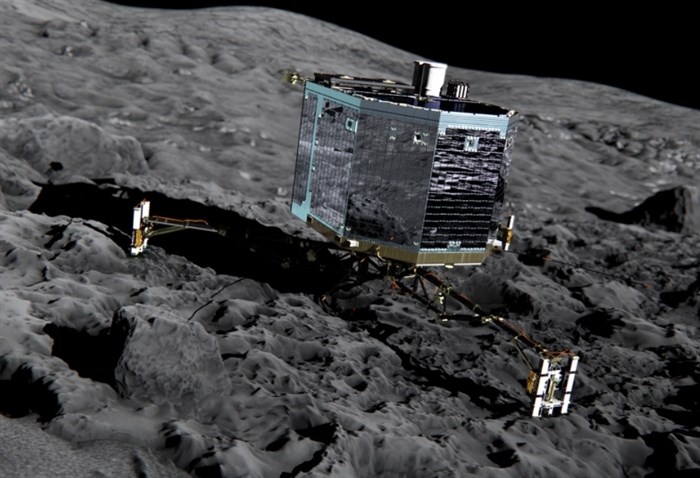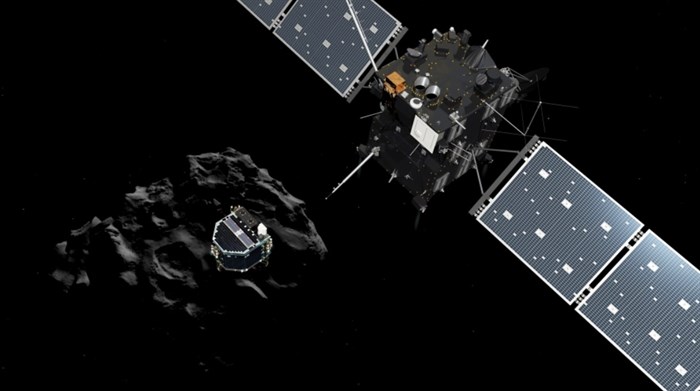
An artist's impression of Rosetta’s lander Philae on the surface of comet 67P/Churyumov-Gerasimenko is pictured in this undated photo.
Image Credit: European Space Agency
June 14, 2015 - 12:56 PM
BERLIN - The comet lander Philae has awoken from a seven-month hibernation and managed to communicate with Earth for more than a minute, the European Space Agency said Sunday.
The probe became the first spacecraft to land on a comet when it touched down on the icy surface of 67P/Churyumov-Gerasimenko in November. After its historic landing, Philae managed to conduct experiments and send data to Earth for about 60 hours before its batteries were depleted and it was forced to shut down its systems.
Scientists hoped the probe would wake up again as the comet approached the sun, when its solar panels would soak up enough light to charge the on-board battery.
Those hopes were confirmed at 10:28 p.m. (2028 GMT; 4:28 p.m. EDT) on Saturday, when the lander sent a signal back to Earth.
"I'm not really surprised it happened, but if you wait for several months and then suddenly in the middle of the night you get a call saying 'we have a signal from Philae,' it's exciting," said Stephan Ulamec, project manager at the German Aerospace Center, or DLR. "We're very happy."
The brief burst of communication contained 300 packages of data that were relayed by the probe's mother ship Rosetta, which is orbiting the comet.
"We only received data for about 85 seconds. These data are housekeeping and system data from the lander," said Ulamec. It was enough to tell scientists that the probe is doing well and getting sufficient sunlight to keep communicating.
Ulamec said the probe appears to have been awake for several days before it called home, because some of the packages scientists received contained historical data.
They will now work to change Rosetta's orbit so that the link to the lander lasts for longer and they can start sending commands for it to carry out new measurements, resulting in fresh scientific data. The next opportunity to communicate with Philae should come on Sunday night, said Ulamec.
Scientists also hope that Philae's restart will allow them to pinpoint where the probe landed. Its exact location has been a mystery, though scientists have narrowed down the likely landing site based on images and other measurements received from Philae and Rosetta.
Comet 67P is currently near the orbit of Mars. On Aug. 13 it will reach the point at which it is closest to the sun — known as perihelion — before swinging back out again. Ulamec said the lander should get enough sunlight to operate until October, when it will once again fall silent, possibly forever.

The image released by the European Space Agency ESA on Nov. 12, 2014 shows an artist's rendering depicting lander Philae separating from the Rosetta mother spaceship and descending to the surface of comet 67P/Churyumov-Gerasimenko.
Image Credit: AP Photo/ESA/ATG Medialab
Here's a look at key moments during the mission:
March 2, 2004: Europe's unmanned probe Rosetta takes off from Kourou, French Guiana, after a series of delays, including an abandoned January 2003 launch window because of a rocket problem.
Feb. 25, 2007: Rosetta carries out a close flyby of Mars. European Space Agency's mission control breaks out in applause after the end of 15 tense minutes of radio silence as the craft passes behind the Red Planet.
Sept. 5, 2008: Probe successfully passes close to an asteroid 250 million miles from Earth. The spacecraft loses its radio signal for 90 minutes as planned during the flyby of the Steins asteroid, also known as Asteroid 2867.
July 10, 2010: Between Mars and Jupiter, Rosetta transmits its first pictures from the largest asteroid ever visited by a satellite after it flies by Lutetia as close as 1,900 miles (3,200 kilometres). It is the closest look to date at the Lutetia asteroid.
Jan. 20, 2014: Waking after almost three years of hibernation, Rosetta sends its first signal back to Earth. Systems had been powered down in 2011 to conserve energy, leaving scientists in the dark for 31 months.
Aug. 6, 2014: Rosetta swings alongside comet 67P/Churyumov-Gerasimenko somewhere between the orbits of Mars and Jupiter.
Nov. 12, 2014: The probe releases the Philae lander and it drops to the comet's surface. Seven hours later, Philae touches down on the comet.
Nov. 15, 2014: Philae goes into hibernation after performing experiments and sending data back to Earth for 60 hours.
Feb. 14, 2015: Rosetta swoops to a distance of just 6 kilometres (less than 4 miles) above the surface of the comet to take close-up pictures of the surface.
June 11, 2015: Scientists say they may have caught a glimpse of Philae, whose exact location remains unknown. After analyzing images and other data collected over the past months they identified several possible sites including one bright spot described as "a good candidate for the lander."
June 13, 2015: Philae communicates with Earth for the first time in seven months in a sign that it has come out of hibernation.
___
Follow Frank Jordans on Twitter at http://www.twitter.com/wirereporter
News from © The Associated Press, 2015